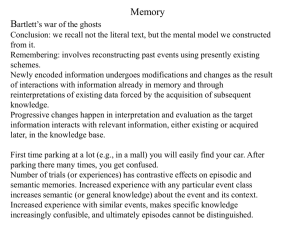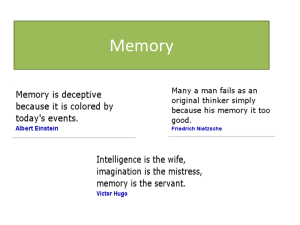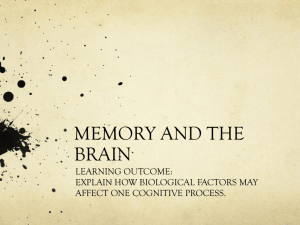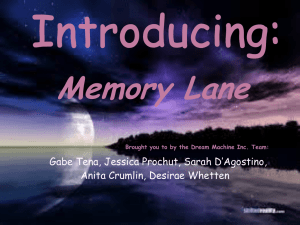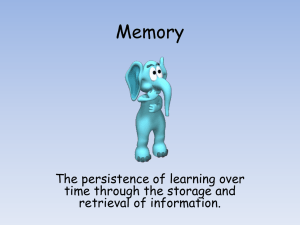Recovered Memories
advertisement
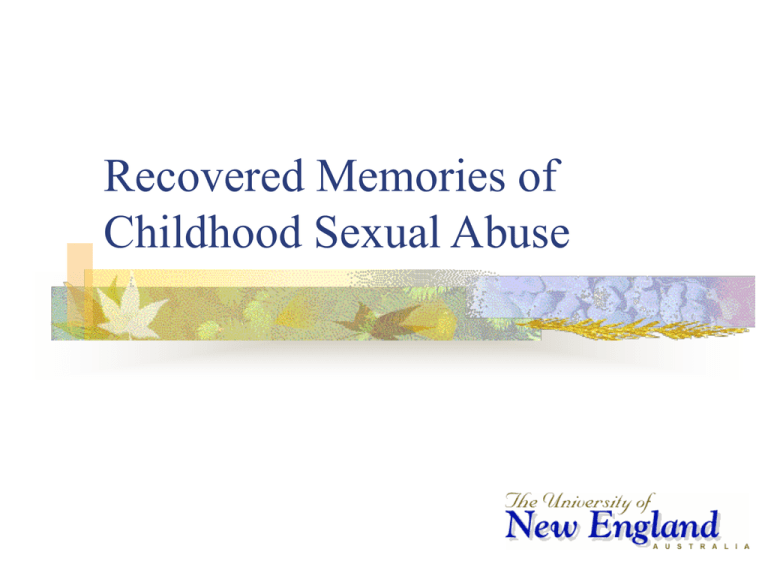
Recovered Memories of Childhood Sexual Abuse Outline Background information Prevalence of childhood sexual abuse Recovered memory therapy The case against RMT Professional consensus on recovered memories Directions for future research Background information 1988-1993 - epidemic of childhood sexual abuse accusations and court cases based on recovered memories, some of which were very bizarre. Alleged perpetrators successfully sued by their children who used recovered memories as their primary source of evidence. Debate about between RM therapists and experimental psychologists about whether recovered memories are accurate representations of the past or illusory memories created during therapy. Who are the accusers?* 92% are female 74% are between ages 31 and 50 31% have at least some post-secondary education 60% report having memories of abuse stemming from events occurring prior to age 4 *Based on statistics from the False Memory Syndrome Foundation What types of accusations are commonly made?* 62% accuse their fathers of abuse. 30% accuse both mother and father of abuse. 18% make allegations of satanic or ritualistic abuse. *Based on statistics from the False Memory Syndrome Foundation Outline Background information Prevalence of childhood sexual abuse Recovered memory therapy The case against RMT Professional consensus on recovered memories Directions for future research Prevalence of Childhood Sexual Abuse Prevalence estimates vary considerably across studies. Burnam (1985) - 6% Wyatt (1985) - 62% Recovered Memory Therapy (RMT) Theoretical Basis for RMT Freud and Repression Emotionally threatening experiences (e.g.,CSA) are banished to the unconscious. Memories are potentially recoverable from unconscious, if anxiety associated with the memory is removed Popular Books “The Courage to Heal” (Ellen Bass & Laura Davis, 1988) “Secret Survivors: Uncovering Incest and its Aftereffects in Women” (E. Sue Blume, 1990) RMT movement argue… (1) CSA is very common. (2) Memories of CSA are often repressed. (3) Common forms of physical and psychological distress are often symptomatic of CSA. (4) Individuals who exhibit symptoms should attempt to recover their abuse memories. What happens in Recovered Memory Therapy? 1 Visit therapist for unrelated reason 2 Therapist suggests symtoms resemble those of previous RMS clients 3 Sessions to recover repressed memories (visualisation, hypnosis, journalling, etc.) 4 Recovery (or reconstruction) of repressed memories (often very vivid and intense) 5 Initially sceptical client becomes convinced he or she was abused Recovery Techniques Remember childhood event, and attempt link abuse to that event Link abuse to family photographs View horror films depicting sexual violence Massage (body memories) Stream of consciousness journaling Hypnotic regression Evidence for repression? Williams (1994) interviewed 129 adults who, as children, were taken to emergency rooms for abuse-related injuries. Two decades later, 20 indicated that they could not remember their hospitalization. Williams found that those who had be most severely abused were more likely to have forgotten the experience. Outline Background information about the debate Prevalence of childhood sexual abuse Recovered memory therapy The case against RMT Professional consensus on recovered memories Directions for future research The case against RMT Evidence against repression Empirical demonstrations of the creation of false memories. Evidence Against Repression Individuals often have “recurrent, intrusive thoughts” about traumatic events (e.g., PTSD symptoms). Holmes (1990) review of 60 years of repression research. All studies supporting the repression concept were flawed. No controlled laboratory studies support the existence of repression. Demonstrations of implanted false memories Roediger & McDermott (1995) Lost in a shopping mall (Loftus & Pickrell, 1995) Lost in a shopping mall study (Loftus & Pickrell, 1995) Goal: To instill a false memory for a mildly traumatic event using techniques similar to those used in RMT. Reminiscence game technique. Results from 14 year old subject Day 1 Day 3 Day 4 Day 5 Day 6 M em ory im planted by older sibling S recalls general feelings about being lost S recalls conversing w ith m other afte r be ing found Recalls additional details about m an w ho found him Recalls spe cific store s in m all and conversation w ith m an Evidence against implantation of “implausible” false memories Pezdek and Hodge (1999) Sample = 39 children aged 5 to 12 Used a procedure similar to Loftus & Pickrell (1995) to compare the ease with which “plausible” and “implausible” memories could be implanted. Results (Pezdek & Hodge, 1999) 25 20 Number of participants who recalled false events. 15 10 5 0 Plausible Both Only Implausible Only Neither Problems with Pezdek Ss in Pezdek’s were asked to try to recall memories over a 3-day period. RMT often goes on for months or years. Research by Ceci suggests that the longer people think about “non-events” the more likely they are to believe them. Problems with Pezdek Pezdek assumes that people do not have well-developed scripts for implausible events such as CSA and ritualistic abuse. But… many people in RMT are encouraged to read abuse self-help books, which will facilitate the development of such scripts. How exactly are false memories created anyway? Heightened client suggestibility combined with bad therapy. Source confusion Heightened Suggestibility Long delay between event and recall Source of misinformation perceived to be credible Heightened Suggestibility Use of hypnosis or relaxation techniques Individual Differences + Bad Therapy Illusory Memory Source Confusion True Memories False Memories Imaginings Key areas of consensus in the recovered memory debate. Most psychologists agree… CSA occurs at an unacceptably high level within society. Satanic and ritualistic abuse is very rare. CSA is positively correlated with psychopathology in adults. Most psychologists also agree… Most people who are victims of CSA remember all or part of what happened to them. Continuous memories of CSA are likely to be accurate. Memories of abuse from early infancy are highly unreliable (“infantile amnesia”). And most psychologists also agree… It is possible to implant false memories using techniques similar to those used in RMT. False memories can be incredibly vivid. The confidence with which one holds a memory is not predictive of the accuracy of that memory. It is impossible to separate accurate from inaccurate memories if RMT has been used. Recovered memories of abuse are not reliable evidence that abuse has actually occurred. Future research is needed to… Determine which therapeutic techniques put clients most at risk for developing false memories. Determine which techniques are most effective in recovering accurate memories. Understand the impact of trauma on memory processes. Determine which types of people are most susceptible to memory suggestion, and why?


